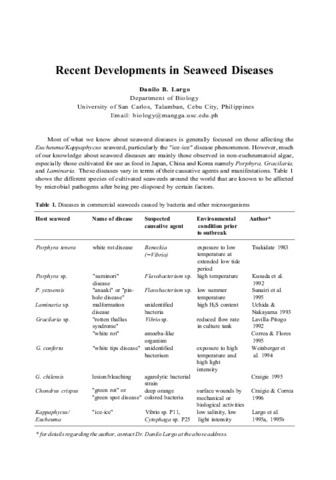Perlihatkan publikasi sederhana
Ice-Ice disease: An environmentally and microbiologically driven syndrome in tropical seaweed aquaculture
| dc.contributor.author | Ward, Georgia | |
| dc.contributor.author | Kambey, Cicilia | |
| dc.contributor.author | Faisan, Joseph P., Jr. | |
| dc.contributor.author | Tan, Pui Ling | |
| dc.contributor.author | Daumich, Caroline | |
| dc.contributor.author | Matoju, Ivy | |
| dc.contributor.author | Stentiford, Grant | |
| dc.contributor.author | Bass, David | |
| dc.contributor.author | Lim, Phaik Eem | |
| dc.contributor.author | Brodie, Juliet | |
| dc.contributor.author | Poong, Sze Wan | |
| dc.date.accessioned | 2021-09-03T02:10:53Z | |
| dc.date.available | 2021-09-03T02:10:53Z | |
| dc.date.issued | 2022-01 | |
| dc.identifier.citation | Ward, G., Kambey, C., Faisan, J., Tan, P. L., Daumich, C., Matoju, I., ... & Poong, S. W. (2021). Ice-Ice disease: An environmentally and microbiologically driven syndrome in tropical seaweed aquaculture. Reviews in Aquaculture, 14(1), 414-439. | en |
| dc.identifier.issn | 1753-5123 | |
| dc.identifier.uri | http://hdl.handle.net/10862/6183 | |
| dc.description.abstract | Seaweeds account for nearly 30% of global aquaculture production by volume, and their cultivation provides important opportunities for employment and wealth generation, particularly in rural coastal communities. Eucheumatoids (Kappaphycus and Eucheuma spp.) are tropical red algae commercially cultivated as raw material for production of carrageenans, particularly in South-East Asia and the Western Indian Ocean region. Diseases and pests are major limiting factors in eucheumatoid production, particularly a condition known as ‘ice-ice’ disease (IID). IID is characterized by bleaching of the thallus followed by the disintegration of affected tissues, leading to a loss of biomass and reduced carrageenan yield. IID has been associated with unfavourable changes in environmental conditions, particularly an increase in sea water temperature and a decrease in salinity, and infection by opportunistic or pathogenic bacteria. However, given that no single or combined causal agents have been definitely identified, IID may be considered a complex pathobiotic syndrome in which multiple factors contribute to the development of disease signs. Here, we review current knowledge of the abiotic and biotic factors associated with the development of IID, and the strategies employed to mitigate economic losses resulting from disease outbreaks. We discuss syndromic diseases in other marine holobionts, particularly other red algae and corals, in relation to their similarity to IID, and suggest the application of comprehensive and complementary methodologies, including high-throughput sequencing and high-quality microscopy, for enhancing our understanding of the pathological and microbiological processes associated with IID signs. | en |
| dc.description.sponsorship | All authors were supported by funding from UKRI for the GlobalSeaweedSTAR project (BB/P027806/1). | en |
| dc.language.iso | en | en |
| dc.publisher | Wiley | en |
| dc.subject | Eucheumatoids | en |
| dc.subject | Holobiont | en |
| dc.subject | Ice-Ice disease | en |
| dc.subject | Pathobiome | en |
| dc.subject | Kappaphycus alvarezii | en |
| dc.title | Ice-Ice disease: An environmentally and microbiologically driven syndrome in tropical seaweed aquaculture | en |
| dc.type | Article | en |
| dc.identifier.doi | 10.1111/raq.12606 | |
| dc.citation.volume | 14 | |
| dc.citation.issue | 1 | |
| dc.citation.spage | 414 | |
| dc.citation.epage | 439 | |
| dc.citation.journalTitle | Reviews in Aquaculture | en |
| dc.subject.asfa | aquaculture | en |
| dc.subject.asfa | seaweed culture | en |
| dc.subject.asfa | seaweeds | en |
| dc.subject.asfa | diseases | en |
| dc.subject.asfa | pathology | en |
| dc.subject.asfa | microbiology | en |
| dc.subject.asfa | domestication | en |
| dc.identifier.essn | 1753-5131 | |
| dc.subject.scientificName | Kappaphycus malesianus | en |
Files in this item
| Files | Size | Format | View |
|---|---|---|---|
|
There are no files associated with this item. |
|||
Publikasi ini ada di koleksi berikut
-
Journal Articles [1256]
These papers were contributed by Department staff to various national and international journals.



